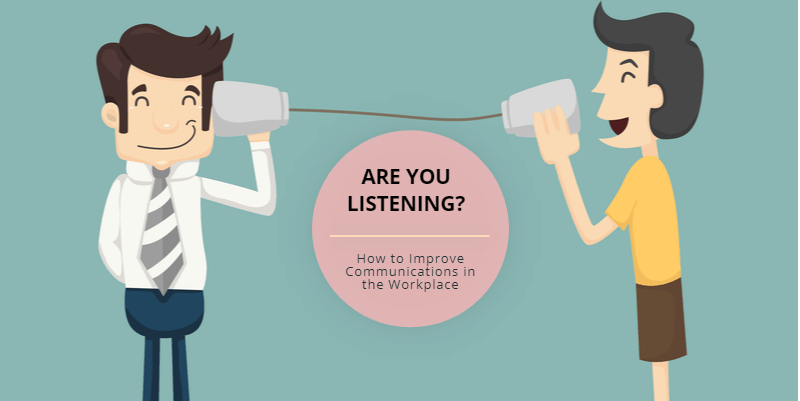Communications is a perennial thorn in the side of many organizations. It doesn’t seem to matter how hard you try, the report card still says there’s room for improvement. And yet we all know if we can improve internal communications in the workplace, productivity, output and company culture all stand to benefit.
The pace of technological change makes it hard to keep on top of the latest digital tools designed to make communication easier. And while technology certainly has a part to play, traditional face-to-face communication is still important.
Workplace communications take place at the organizational level and also on the individual level – especially in the relationship between manager and employee. For a comprehensive look at how to improve communications in the workplace, check out the following 20 top tips.

20 Ways To Fix Poor Workplace Communication
Do it well, and workplace communication helps drive businesses forward. Employees feel empowered and understand the company’s mission and their contribution to the big picture. Getting workplace communication right isn’t just nice to have. Nowadays, it’s a necessity if you want to remain competitive.
If you think communication problems are holding your business back, check out these practical solutions and get back on track.
1. Audit Communication Methods
Do you know what the lines of communication are in your business? Or have these communication methods simply evolved over time without much central oversight? Before you can determine how to improve communication in the workplace, it’s essential to know the current methods and what’s working well.
It’s likely you are already using some of these tools: email, messaging apps, video conferencing, staff briefings, newsletters, intranet software or social media. But which ones are the most effective? What methods suit your workplace dynamic best? Start by inviting staff to feedback about their preferences. Do an audit of communication methods. That way you will have a much better understanding of what’s a good fit for your business.
2. Actively Listen
Communication isn’t a one-way process. A meaningful dialogue involves actively listening to what your team members have to say. Make sure you give the conversation your full attention – turn your phone off and let others know you are unavailable for the duration of the 1:1 meeting. Ask questions for clarification, keep a note of your discussions and be sure to follow up on any action points.
The same approach applies to team or departmental meetings. Supplement regular team meetings with surveys and polls to encourage participation and feedback from staff. These are also a great option for reaching out to the telecommuters, freelancers and non-desk workers in your team.
You could take this a step further by implementing a staff suggestion scheme. A traditional but still effective option, it’s possible to replicate the suggestion box with a virtual one on the intranet. Allowing employees to share their views, concerns or insights sets the right environment of openness and approachability.
3. Develop Mechanisms For Two-Way Conversations
It’s surprising how many organizations make the mistake of seeing communication as being one-way traffic: Corporate messages are passed down through the company ranks but very little comes back up.
To be really effective at improving communication in the workplace, involve genuine two-way conversations with staff members. Senior managers need to actively listen.
Encourage an open-door policy where staff feel able to approach their supervisors. Promote this policy throughout your internal communication channels. Walk the talk via visible leadership in which managers interact with staff members, attend team meetings, listen to feedback. And importantly, loop back on the next steps.
In this context, digital communication tools have an important role to play. Wikis, blogs, intranet news feeds, instant messaging apps and social intranet features enable management to develop genuine conversations.
Like many companies, UK-based recruitment consultancy Kenect Recruitment, experienced communication issues. With 14 regional offices, developing two-way conversations between management and a dispersed workforce was a challenge.
“We wanted a digital platform that could bridge the communication gap between the directors and staff, as well as providing our employees with quick and easy access to the information and resources they need,” advises Kenect’s Managing Director, Jason Whittenham.
For Kenect the perfect solution was an intranet platform. The intranet’s integral corporate and team news blogs – alongside a comprehensive content management system – have led to more open and transparent relationships with staff. The end result has been more efficient and effective working – and a noticeably improved company culture. Read more about Kenect’s intranet experience.
4. Mobile Technologies
For staff who telecommute or work non-desk roles, mobile technologies are an essential line of communication. Businesses need to ensure these staff members feel as connected as head office-based staff.
Certainly for Idaho State Lottery and its dispersed, mobile workforce, internal communications was a big issue. “We used email as our main communication tool but found that it wasn’t working for us anymore,” explains Jennifer Quinno-Miller, Management Assistant/Human Resources. The ability to securely share information with staff out in the field was another key issue. After extensive research, an intranet platform was the mobile solution selected by Idaho State Lottery. As well as being an important communication vehicle, the intranet is also the central hub for all the company’s information and data needs. “Staff can directly and securely source and access anything they need, even if they’re away from the office,” says Jennifer.
5. Publish A Regular Newsletter
Tried and tested, newsletters are an enduring technique to improve communication in the workplace. As well as being a vehicle for updating staff on important news and events, a newsletter is also a good way to build a strong company culture. Traditional, printed formats have been replaced with visually-striking online versions incorporating a variety of media for maximum appeal.
Let’s look, for example, at a healthcare organization with around 300 staff. Their communication challenges are around shift-workers, non-desk employees and siloed teams. For this organization, message cut-through relies upon ease of access and quick-to-grasp content. Instead of an email from the CEO, a vlog could be more effective (sent direct to mobiles) at reaching those working irregular hours and non-desk roles.
In addition, to help break down information silos, include success stories about joint working and collaboration. Profiling the work of other teams or individuals in a special feature are also useful ways of developing a common sense of purpose and building connections between teams.
The healthcare industry is constantly changing. New regulations and government initiatives, variations in compliance reporting, an internal restructure … staff must be informed as well as know about best practice. An online newsletter ensures that all employees receive the same timely and consistent messages. Include bite-sized snippets of text with an option to click through for more detail. And using lots of graphics, videos and diagrams will make even dense information more accessible and gives it instant visual appeal.
6. Implement Intranet Software
Today’s diverse workplaces call for flexible and versatile communication methods. Mobile-optimized and with in-built two-way communication channels such as blogs, wikis and online newsletters, intranets offer businesses that all-important versatility and flexibility. But there are other business benefits too, summed up by Jessica Fisher from RWR Group:
“We thought it would mainly address the communication need. But it has centralized all our business processes in one location. We use it as a central library of information with all our how-to guides, policies and processes, as well as HR forms”.
7. Be Clear About Expectations
One of the major blocks to communication is a lack of clarity around role expectations. Role expectations is different from a job description which merely lists responsibilities rather than how a team melds together. Role expectations can be set around a project team, a specific task or even how the employee fits into the big corporate picture.
Communication can quickly break down when people don’t fully understand their role and what’s expected of them. As the manager, it’s your job to make sure staff have role clarity. Make it clear what the employee needs to do to be successful. Be upfront about the metrics you are using to assess performance. Set clear terms of reference, accountabilities, and goals for any project teams so there is clarity from the outset.
The transparency and strong sense of direction will enhance overall organizational communication.
8. Set Up Weekly Or Monthly 1:1 Meetings
Prioritize regular catch-ups with your team members. Face-to-face communication is still important – even in the digital age. 1:1 meetings are a good way to discuss how work is going, identify any roadblocks, celebrate successes and communicate corporate news. It doesn’t always have to be a formal meeting. In fact, taking time away from the office and getting together at say a coffee shop is often more effective. This is also an option for remote working or non-desk staff. And if the geographical distance involved makes regular face-to-face communication impossible, then video conferencing apps are the next best thing.
When work is super busy, it’s tempting to cancel regular catch-up meetings with your staff. However, this is frustrating and annoying for employees. It can easily send the wrong message about how much you value team members. Do your best to avoid canceling these important meetings.
9. Review The Layout Of The Workplace
Is the setup of your office enabling or hindering effective communication? The design and layout of the workplace can have a big impact on internal communications. Separate offices and small cubicles – while keeping staff focused and free from distractions – can act as a barrier to communication and therefore efficient collaboration. Departmental silos are often the result.
On the other hand, a more open-plan design that includes a centralized social hub – based around the water cooler or office kitchen – can facilitate communication between teams.
A mix of open plan, collaborative project spaces alongside private cubicles for 1:1 meetings and focused work offers the best of both worlds.
10. Develop A Communications Strategy
Don’t leave your internal communications to chance. If you are serious about improving communication, take control by developing a strategy. Check out our Internal Communications Strategy: 15 Tips post for all you need to know. The bottom line is that a plan will focus attention by setting out a budget, expectations, and measurable goals. Not only will it help leaders to be more effective communicators, but it also introduces transparency and accountability.
11. Know Your Audience
As we have seen, one of the stumbling blocks to effective communication in the workplace is that we assume too much. You may think you know what employees want and need, but do you really? Engage with your people to fully understand their needs. And remember, there will be more than one internal audience. Different cultures, teams, job roles, and even generations will have differing requirements.
12. Use The Right Channels To Communicate At The Right Time
Close any communication gaps by ensuring everyone uses the proper channels at the right time. For example, a critical project update is best delivered by business IM. An emailed update will only get buried in overflowing inboxes. Decide what type of messages you typically need to provide and the most appropriate channel. Then, ensure staff members are aware of your expectations.
13. Professional Development For Managers
Not every manager is an effective communicator. Even good leaders can benefit from professional development. Set up a program of comms training for all leaders. That way, you keep their skills and knowledge sharp. Active listening skills, questioning techniques to clarify understanding, and providing feedback are just some of the skills your leaders need.
And remember to include training on varied nonverbal cues. Only a surprising seven percent of our communication is verbal. Often, we forget how much we convey through our body language, tone of voice, and posture. Your managers may not realize that body language accounts for 55 percent of daily communication.
14. Take Control Of Meetings
Love ‘em or loathe ‘em, meetings are a fact of life in every business, making them a vital comms channel. Poorly run meetings are a waste of everyone’s time. Make sure yours are effective by encouraging a few good habits.
Keep get-togethers short and focused, with an agenda sent out in advance. Invite only those employees who need to be there and effectively chair the meetings by keeping everyone on topic. Make sure you come up with clear action steps for participants to take away. And finally, set aside time to communicate. In the rush to get things done, we don’t give ourselves the space to communicate. Dedicate five or ten minutes to share news, updates, or insights in every meeting.
15. Connect With Remote Employees
Remote working or hybrid employees often feel out of the loop. They don’t have the same opportunities to connect as their in-person colleagues. Organizations have to work harder to keep the lines of communication open. Thankfully, the tech is there to make that happen. Whether it’s intranets, video conferencing, or messaging apps, make sure your remote employees are part of the conversation.
16. Develop A Culture Of Appreciation
It’s a fact that people work better when their efforts are recognized. According to a Gallup survey, 74 percent said receiving praise made them feel more valuable.
However, when it comes to workplace comms, we often focus on the negatives. We spend time examining what went wrong and analyzing mistakes. However, it’s just as important to emphasize the positives and give praise when it’s due. An employee recognition program is a powerful platform for managers to communicate gratitude. Sharing success stories empowers and encourages the workforce to improve continuously.
17. Centralize Resources And Information
Whether internal documents, company policies, or project descriptions, ensure employees can access all the resources they need. Free and easy access to company knowledge helps with the flow of information. And it means employees can find answers to questions without asking their colleagues or superiors. A centralized platform like the intranet does away with confusion and uncertainty, making it easier to work effectively.
18. Invest In IM
Fast and effective, business IM levels the communication playing field for all employees, including remote ones. Issues can be addressed immediately, decision-making is speeded up, and sharing of ideas and information is streamlined.
What’s more, tagged channels, threads, alerts, and notifications boost relevancy and address the problem of overload. Your people will love the personalization options in team chat. And features like emojis add an irresistible, fun element.
19. Encourage And Embrace Feedback
Communication is an evolving process that requires constant review and reflection. As a manager, it’s important to embrace and encourage staff to feedback on your performance as a communicator. After all, the only way to improve is to act on constructive feedback.
Use the regular staff 1:1s to ask for feedback. Alternatively, use the intranet’s surveys and polls function to find out what staff really think about workplace communication both on the managerial and corporate level. Make it anonymous and you will be more likely to receive honest feedback. Furthermore, review and reflection should be an ongoing process throughout the year and not just an annual exercise.
20. Mix Things Up
When it comes to communication, we usually think of verbal or written communication. But there are other ways to reach workers. In fact, mixing things up with different options can mean you reach even more employees.
Instead of relying on a printed newsletter or team meetings, why not use videos, podcasts, infographics, and images? Variety is the spice of life, so the old saying goes. If you want to improve communication, try incorporating new media, which may resonate more with your employees of different backgrounds and preferences.
Are you motivated to turn around poor communication in the workplace? Get in touch with the expert team at MyHub. Our easy-to-use intranet software may be just what you need. Under one virtual roof are all the tools and features your business needs to improve communication and transform the workplace. Sign up for a free demo or 14-day trial today.









